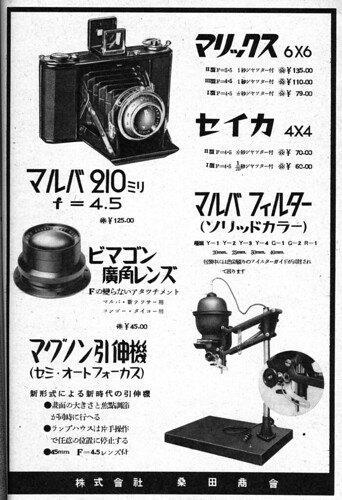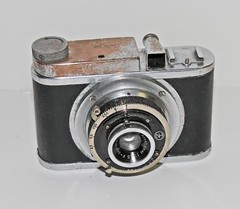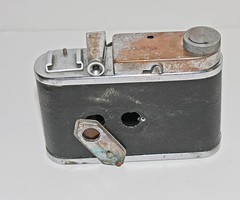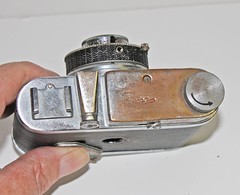Difference between revisions of "Seica and Andes Four"
Rebollo fr (talk | contribs) m (→The Seica: ultra minor) |
Hanskerensky (talk | contribs) m (→Links: Repaired Link URL) |
||
| (22 intermediate revisions by 4 users not shown) | |||
| Line 1: | Line 1: | ||
| − | {{Japanese Baby and Four}} | + | {{Japanese Baby and Four |
| + | |image=[http://www.flickr.com/photos/camerawiki/46280338585/in/pool-camerawiki/ http://farm8.staticflickr.com/7904/46280338585_bd0c7074f2_m_d.jpg]<br>''Picture courtesy of [http://www.jay-tepper.com/ Jay Tepper]. {{with permission}}'' | ||
| + | }} | ||
''See also the [[Seica (4.5×6)]] rangefinder folding camera.'' | ''See also the [[Seica (4.5×6)]] rangefinder folding camera.'' | ||
| − | The '''Seica''' (セイカ or 精華) and '''Andes Four''' (アンデスフォアー) are Japanese cameras taking 4×4cm pictures on [[127 film]]. They are nearly identical except for the name and they were probably name variants of each other. The Andes Four was distributed by [[Misuzu Shōkai]] and the Seica by [[Kuwata|Kuwata Shōkai]]. They were certainly made by the same company. Some sources attribute the two cameras to a company called [[Kondo|Kondo Seikō]], whereas others attribute the Seica to [[Ricoh|Riken Kōgaku Kōgyō]].<REF> Kondo Seikō: {{ | + | The '''Seica''' (セイカ or 精華) and '''Andes Four''' (アンデスフォアー) are Japanese cameras taking 4×4cm pictures on [[127 film]]. They are nearly identical except for the name and they were probably name variants of each other. The Andes Four was distributed by [[Misuzu Shōkai]] and the Seica by [[Kuwata|Kuwata Shōkai]]. They were certainly made by the same company. Some sources attribute the two cameras to a company called [[Kondo|Kondo Seikō]], whereas others attribute the Seica to [[Ricoh|Riken Kōgaku Kōgyō]].<REF> Kondo Seikō: {{SUG}}, items 3003 and 3051; {{MK}}, p.537. Riken Kōgaku Kōgyō: {{Kokusan}}, p.337, {{KKS}} no.14, p.21. </REF> It is said that the [[Cordlef]] 4×4 TLR is based on the body of the Seica and Andes Four. |
== General description == | == General description == | ||
| − | The Seica and Andes Four have a metal body with round edges and a telescopic tube supporting the lens and shutter assembly. The tubular optical finder is offset to the left and there is an accessory shoe at the left end of the top plate. The right half of the top plate is covered by a long housing, supporting the advance knob at the right end and containing an exposure counter. It is said that there is no automatic stop device and that the film advance is controlled by the exposure counter alone (some control device was necessary because the rollfilm paper backing was not marked for 4×4cm pictures at the time).<REF> No auto-stop advance: {{KKS}} no.14, p.21, and {{Kokusan}}, p.337 (item 132). </REF> There is a lever behind the top housing, certainly used to reset the exposure counter.<REF> Use of the lever: {{KKS}} no.14, p.21. </REF> The back is fixed and the film is loaded through the removable bottom plate. There is a single red window | + | The Seica and Andes Four have a metal body with round edges and a telescopic tube supporting the lens and shutter assembly. The tubular optical finder is offset to the left and there is an accessory shoe at the left end of the top plate. The right half of the top plate is covered by a long housing, supporting the advance knob at the right end and containing an exposure counter. It is said that there is no automatic stop device and that the film advance is controlled by the exposure counter alone (some control device was necessary because the [[rollfilm]] paper backing was not marked for 4×4cm pictures at the time).<REF> No auto-stop advance: {{KKS}} no.14, p.21, and {{Kokusan}}, p.337 (item 132). </REF> There is a lever behind the top housing, certainly used to reset the exposure counter.<REF> Use of the lever: {{KKS}} no.14, p.21. </REF> |
| + | |||
| + | The back is fixed and the film is loaded through the removable bottom plate. There is a single [[red window]] offset to the left, protected by a horizontally sliding cover and used to set the position of the first exposure. | ||
== The Seica == | == The Seica == | ||
| − | On the Seica models, the name ''Seica'' is engraved on the exposure counter housing. The camera was featured in the new products column of the January 1939 issue of | + | On the Seica models, the name ''Seica'' is engraved on the exposure counter housing. |
| + | |||
| + | === Documents === | ||
| + | The camera was featured in the new products column of the January 1939 issue of {{ACA}}.<REF name="Kokusan 337"> {{Kokusan}}, p.337. </REF> It seems that it was attributed to [[Ricoh|Riken Kōgaku Kōgyō]], but it is not known if this was the maker or the distributor. The camera name was written 精華, meaning "bloom", "flower" or "elite". (During the war period, Riken used "patriotic" names, as well as names reminding Japan's alliance with Germany.) The lens was announced as a Seica 50/4.5 and the shutter as giving T, B, 5–250 speeds.<REF name="Kokusan 337" /> It was advertised by [[Ricoh|Riken Kōgaku Kōgyō]] in February 1939 for {{yen|70|1939}}, the name being written 精華 again.<REF> Advertisement for the Riken camera range published in the 26 February 1939 issue of ''[[Sunday Mainichi]]'', formerly reproduced in the [https://web.archive.org/web/20100703164808/http://kyoto.cool.ne.jp/syasinsyuu/index.htm Gochamaze (archived)] website. </REF> | ||
| + | |||
| + | {| class="plainlinks" align="center" width=400px style="text-align: center;" | ||
| + | || [http://www.flickr.com/photos/camerawiki/47195159041/in/pool-camerawiki/ http://farm8.staticflickr.com/7805/47195159041_d39a23d3fa.jpg] | ||
| + | |- | ||
| + | || ''Advertisement in {{ACA}} April 1941,<br>mentioning the Seica. {{public domain Japan old}}'' | ||
| + | |} | ||
| − | + | The Seica was advertised in {{ACA}} from September 1940 to June 1941 by the distributor [[Kuwata|Kuwata Shōkai]],<REF> {{Kokusan}}, p.337. </REF> with no mention of [[Ricoh|Riken]]. The distribution of the camera was perhaps transferred from Riken to Kuwata, while it was produced by a third party, perhaps [[Kondo|Kondo Seikō]]. The advertisements dated October 1940, February and April 1941 give the name セイカ in ''katakana'' script; only that dated February shows a picture of the camera.<REF> Advertisements in {{ACA}} October 1940 and February 1941, reproduced in {{Kokusan}}, pp.77 and 95, and advertisement in {{ACA}} April 1941, p.512. </REF> All the documents list two versions, both with an f/4.5 lens whose name is not specified: | |
* '''Seica I''': T, B, 25–250 speeds ({{yen|60|1941}} in 1941); | * '''Seica I''': T, B, 25–250 speeds ({{yen|60|1941}} in 1941); | ||
* '''Seica II''': T, B, 5–250 speeds ({{yen|70|1941}} in 1941). | * '''Seica II''': T, B, 5–250 speeds ({{yen|70|1941}} in 1941). | ||
| − | The Seica I and Seica II | + | The Seica I and Seica II also appear in the list of set prices compiled in October 1940 and published in January 1941, at respectively ¥60 and ¥77.<REF> {{Kakaku0141_short}}, type 1, sections 5 and 7. </REF> |
| + | |||
| + | === Actual examples === | ||
| + | {| class="plainlinks" align="center" style="text-align: center;" | ||
| + | || [http://www.flickr.com/photos/camerawiki/46280338585/in/pool-camerawiki/ http://farm8.staticflickr.com/7904/46280338585_bd0c7074f2_m_d.jpg] [http://www.flickr.com/photos/camerawiki/47142894862/in/pool-camerawiki/ http://farm8.staticflickr.com/7827/47142894862_d30c0544d7_m_d.jpg] [http://www.flickr.com/photos/camerawiki/32252666177/in/pool-camerawiki/ http://farm8.staticflickr.com/7879/32252666177_8b752f10c5_m_d.jpg] | ||
| + | |- | ||
| + | || ''Seica, Helios Anastigmat 5cm f/4.5 lens, [[Perfect]] shutter (25–250, B, T).''<br>''Pictures courtesy of [http://www.jay-tepper.com/ Jay Tepper]. {{with permission}}'' | ||
| + | |} | ||
| − | + | Only a few surviving examples have been observed. Some of them have a [[Perfect]] shutter by [[Neumann & Heilemann]], giving 25, 50, 100, 250, B, T speeds, and a front-cell focusing Helios Anastigmat 5cm f/4.5 lens.<REF> Examples pictured in this page, in {{MK}}, p.537, in {{KKS}} no.14, p.21 (one of the pictures is reproduced in [http://www.ricoh-imaging.co.jp/japan/products/ricoh-filmcamera/cameralist/seica.html this page of the Ricoh official website]) and sold as [http://www.liveauctioneers.com/item/1715121 lot no.78] in the 25 March 2006 sale by Auction Team Breker. </REF> (Some sources showing a camera with Helios lens nonetheless mention a Seica 60/3.5, surely by mistake.)<REF> ''Senzen no rikō kamera – hoi'', p.21 of {{KKS}} no.14, and [http://www.ricoh-imaging.co.jp/japan/products/ricoh-filmcamera/cameralist/seica.html this page of the Ricoh official website]. </REF> On these, the shutter plate has the name ''PERFECT'' engraved at the bottom, a ''Neumann & Heilemann'' nameplate screwed to the top, and a round ''NH'' logo on the right. The aperture scale is written on another crescent-shaped metal plate screwed to the bottom. The Helios lens, also found on the [[Baby Germa]], was made by [[Tōkyō Shashin|Tōkyō Shashin Kōgaku]].<REF> {{Inquiry1943_short}}, lens item Jc12 for an Helios 50/4.5 lens mounted on the [[Baby Germa]]. </REF> | |
| − | + | One isolated example has been observed with a Magnon Anastigmat 50/4.5 lens and an unnamed [[everset shutter]] giving T, B, 150, 100, 50, 25 speeds.<REF> Example pictured in an online auction. </REF> The Magnon brand was also used by [[Kuwata]] for enlarging lenses. The shutter plate is marked ''Patents–Pending'' at the top and has a logo on the right, probably reading ''FB'' and exactly similar to the logo found on the shutter plate of the [[Mulber Six]] which was also distributed by Kuwata. | |
== The Andes Four == | == The Andes Four == | ||
| − | The '''Andes Four''' is identical to the Seica except for the name and the lens and shutter equipment. The name ''ANDES'' is written on a nameplate attached above the exposure counter housing. | + | The '''Andes Four''' is identical to the Seica except for the name and the lens and shutter equipment. The name ''ANDES <small>FOUR</small>'' is written on a nameplate attached above the exposure counter housing. It is also repeated at the front of the ever-ready case. The lens is a front-cell focusing 50mm f/3.5. The shutter is [[everset]] and gives T, B, 150, 100, 50, 25 speeds. Its front plate is marked ''VERIO'' at the top and ''<small>2600</small>'' at the bottom, and has an aperture scale from 3.5 to 16 at the bottom. |
| + | |||
| + | The Andes Four is listed in the January 1941 official price list cited above, under the names "Andes I" (¥60) and "Andes II" (¥77).<REF> {{Kakaku0141_short}}, type 1, sections 5 and 7. </REF> It is also featured in the March 1941 issue of {{ACA}}, where it is attributed to [[Misuzu Shōkai]], certainly the distributor, and called '''Andes Four II'''.<REF> {{Kokusan}}, p.334. </REF> | ||
| − | + | Two surviving examples of the camera have been observed so far. The lens name is engraved as ''ANDES Anastigmat''<REF> Example pictured in {{SUG]}}, item 3003. A smaller version of the same picture is reproduced in {{Kokusan}}, p.334. </REF> or ''ANDAS Anastigmat''<REF> Example observed in an online auction (lens no.3106). </REF> — the latter is surely the result of an engraving mistake. | |
== Notes == | == Notes == | ||
| Line 28: | Line 50: | ||
== Bibliography == | == Bibliography == | ||
| + | === Original documents === | ||
| + | * {{ACA}}. Advertisement by [[Kuwata|Kuwata Shōkai]] in April 1941, p.512. | ||
| + | * {{Kakaku0141}} Type 1, sections 5 and 7. | ||
| + | |||
| + | === Recent sources === | ||
* {{Showa10}} Items 17 and 132–3. | * {{Showa10}} Items 17 and 132–3. | ||
| − | |||
* {{McKeown12}} P.537. | * {{McKeown12}} P.537. | ||
* {{Zukan}} Items 3003 and 3051. | * {{Zukan}} Items 3003 and 3051. | ||
| Line 39: | Line 65: | ||
* [http://www.liveauctioneers.com/item/1715121 Seica]: lot 78 of the [http://www.liveauctioneers.com/catalog/8902 March 25, 2006 Photographica and Film auction] by Auction Team Breker | * [http://www.liveauctioneers.com/item/1715121 Seica]: lot 78 of the [http://www.liveauctioneers.com/catalog/8902 March 25, 2006 Photographica and Film auction] by Auction Team Breker | ||
In Japanese: | In Japanese: | ||
| − | * Pages of the [http://www.ricoh.co.jp/ Ricoh official website]: | + | * Pages of the [http://www.ricoh-imaging.co.jp/japan/index.html Ricoh official website]: |
| − | ** [http://www.ricoh.co.jp/ | + | ** [http://www.ricoh-imaging.co.jp/japan/products/ricoh-filmcamera/cameralist/seica.html Seica] in the [http://www.ricoh-imaging.co.jp/japan/products/ricoh-filmcamera/cameralist/ camera list] |
| − | ** [http://www.ricoh.co.jp/ | + | ** [http://www.ricoh-imaging.co.jp/japan/products/ricoh-filmcamera_lib/column/war-camera.html article about Riken wartime camera names] |
| − | |||
Latest revision as of 05:26, 29 May 2021
See also the Seica (4.5×6) rangefinder folding camera.
The Seica (セイカ or 精華) and Andes Four (アンデスフォアー) are Japanese cameras taking 4×4cm pictures on 127 film. They are nearly identical except for the name and they were probably name variants of each other. The Andes Four was distributed by Misuzu Shōkai and the Seica by Kuwata Shōkai. They were certainly made by the same company. Some sources attribute the two cameras to a company called Kondo Seikō, whereas others attribute the Seica to Riken Kōgaku Kōgyō.[1] It is said that the Cordlef 4×4 TLR is based on the body of the Seica and Andes Four.
Contents
General description
The Seica and Andes Four have a metal body with round edges and a telescopic tube supporting the lens and shutter assembly. The tubular optical finder is offset to the left and there is an accessory shoe at the left end of the top plate. The right half of the top plate is covered by a long housing, supporting the advance knob at the right end and containing an exposure counter. It is said that there is no automatic stop device and that the film advance is controlled by the exposure counter alone (some control device was necessary because the rollfilm paper backing was not marked for 4×4cm pictures at the time).[2] There is a lever behind the top housing, certainly used to reset the exposure counter.[3]
The back is fixed and the film is loaded through the removable bottom plate. There is a single red window offset to the left, protected by a horizontally sliding cover and used to set the position of the first exposure.
The Seica
On the Seica models, the name Seica is engraved on the exposure counter housing.
Documents
The camera was featured in the new products column of the January 1939 issue of Asahi Camera.[4] It seems that it was attributed to Riken Kōgaku Kōgyō, but it is not known if this was the maker or the distributor. The camera name was written 精華, meaning "bloom", "flower" or "elite". (During the war period, Riken used "patriotic" names, as well as names reminding Japan's alliance with Germany.) The lens was announced as a Seica 50/4.5 and the shutter as giving T, B, 5–250 speeds.[4] It was advertised by Riken Kōgaku Kōgyō in February 1939 for ¥70, the name being written 精華 again.[5]

|
| Advertisement in Asahi Camera April 1941, mentioning the Seica. (Image rights) |
The Seica was advertised in Asahi Camera from September 1940 to June 1941 by the distributor Kuwata Shōkai,[6] with no mention of Riken. The distribution of the camera was perhaps transferred from Riken to Kuwata, while it was produced by a third party, perhaps Kondo Seikō. The advertisements dated October 1940, February and April 1941 give the name セイカ in katakana script; only that dated February shows a picture of the camera.[7] All the documents list two versions, both with an f/4.5 lens whose name is not specified:
The Seica I and Seica II also appear in the list of set prices compiled in October 1940 and published in January 1941, at respectively ¥60 and ¥77.[8]
Actual examples
  
|
| Seica, Helios Anastigmat 5cm f/4.5 lens, Perfect shutter (25–250, B, T). Pictures courtesy of Jay Tepper. (Image rights) |
Only a few surviving examples have been observed. Some of them have a Perfect shutter by Neumann & Heilemann, giving 25, 50, 100, 250, B, T speeds, and a front-cell focusing Helios Anastigmat 5cm f/4.5 lens.[9] (Some sources showing a camera with Helios lens nonetheless mention a Seica 60/3.5, surely by mistake.)[10] On these, the shutter plate has the name PERFECT engraved at the bottom, a Neumann & Heilemann nameplate screwed to the top, and a round NH logo on the right. The aperture scale is written on another crescent-shaped metal plate screwed to the bottom. The Helios lens, also found on the Baby Germa, was made by Tōkyō Shashin Kōgaku.[11]
One isolated example has been observed with a Magnon Anastigmat 50/4.5 lens and an unnamed everset shutter giving T, B, 150, 100, 50, 25 speeds.[12] The Magnon brand was also used by Kuwata for enlarging lenses. The shutter plate is marked Patents–Pending at the top and has a logo on the right, probably reading FB and exactly similar to the logo found on the shutter plate of the Mulber Six which was also distributed by Kuwata.
The Andes Four
The Andes Four is identical to the Seica except for the name and the lens and shutter equipment. The name ANDES FOUR is written on a nameplate attached above the exposure counter housing. It is also repeated at the front of the ever-ready case. The lens is a front-cell focusing 50mm f/3.5. The shutter is everset and gives T, B, 150, 100, 50, 25 speeds. Its front plate is marked VERIO at the top and 2600 at the bottom, and has an aperture scale from 3.5 to 16 at the bottom.
The Andes Four is listed in the January 1941 official price list cited above, under the names "Andes I" (¥60) and "Andes II" (¥77).[13] It is also featured in the March 1941 issue of Asahi Camera, where it is attributed to Misuzu Shōkai, certainly the distributor, and called Andes Four II.[14]
Two surviving examples of the camera have been observed so far. The lens name is engraved as ANDES Anastigmat[15] or ANDAS Anastigmat[16] — the latter is surely the result of an engraving mistake.
Notes
- ↑ Kondo Seikō: Sugiyama, items 3003 and 3051; McKeown, p.537. Riken Kōgaku Kōgyō: Kokusan kamera no rekishi, p.337, Kurashikku Kamera Senka no.14, p.21.
- ↑ No auto-stop advance: Kurashikku Kamera Senka no.14, p.21, and Kokusan kamera no rekishi, p.337 (item 132).
- ↑ Use of the lever: Kurashikku Kamera Senka no.14, p.21.
- ↑ 4.0 4.1 Kokusan kamera no rekishi, p.337.
- ↑ Advertisement for the Riken camera range published in the 26 February 1939 issue of Sunday Mainichi, formerly reproduced in the Gochamaze (archived) website.
- ↑ Kokusan kamera no rekishi, p.337.
- ↑ Advertisements in Asahi Camera October 1940 and February 1941, reproduced in Kokusan kamera no rekishi, pp.77 and 95, and advertisement in Asahi Camera April 1941, p.512.
- ↑ "Kokusan shashinki no kōtei kakaku", type 1, sections 5 and 7.
- ↑ Examples pictured in this page, in McKeown, p.537, in Kurashikku Kamera Senka no.14, p.21 (one of the pictures is reproduced in this page of the Ricoh official website) and sold as lot no.78 in the 25 March 2006 sale by Auction Team Breker.
- ↑ Senzen no rikō kamera – hoi, p.21 of Kurashikku Kamera Senka no.14, and this page of the Ricoh official website.
- ↑ "Kokusan shashinki no genjōchōsa" ("Inquiry into Japanese cameras"), lens item Jc12 for an Helios 50/4.5 lens mounted on the Baby Germa.
- ↑ Example pictured in an online auction.
- ↑ "Kokusan shashinki no kōtei kakaku", type 1, sections 5 and 7.
- ↑ Kokusan kamera no rekishi, p.334.
- ↑ Example pictured in {{SUG]}}, item 3003. A smaller version of the same picture is reproduced in Kokusan kamera no rekishi, p.334.
- ↑ Example observed in an online auction (lens no.3106).
Bibliography
Original documents
- Asahi Camera. Advertisement by Kuwata Shōkai in April 1941, p.512.
- "Kokusan shashinki no kōtei kakaku" (国産写真機の公定価格, Set prices of the Japanese cameras), listing Japanese camera production as of October 25, 1940 and setting the retail prices from December 10, 1940. Published in Asahi Camera January 1941 and reproduced in Shōwa 10—40nen kōkoku ni miru kokusan kamera no rekishi (昭和10〜40年広告にみる国産カメラの歴史, Japanese camera history as seen in advertisements, 1935—1965). Tokyo: Asahi Shinbunsha, 1994. ISBN 4-02-330312-7. Pp.108—9. Type 1, sections 5 and 7.
Recent sources
- Asahi Camera (アサヒカメラ) editorial staff. Shōwa 10–40nen kōkoku ni miru kokusan kamera no rekishi (昭和10–40年広告にみる国産カメラの歴史, Japanese camera history as seen in advertisements, 1935–1965). Tokyo: Asahi Shinbunsha, 1994. ISBN 4-02-330312-7. Items 17 and 132–3.
- McKeown, James M. and Joan C. McKeown's Price Guide to Antique and Classic Cameras, 12th Edition, 2005-2006. USA, Centennial Photo Service, 2004. ISBN 0-931838-40-1 (hardcover). ISBN 0-931838-41-X (softcover). P.537.
- Sugiyama, Kōichi (杉山浩一); Naoi, Hiroaki (直井浩明); Bullock, John R. The Collector's Guide to Japanese Cameras. 国産カメラ図鑑 (Kokusan kamera zukan). Tokyo: Asahi Sonorama, 1985. ISBN 4-257-03187-5. Items 3003 and 3051.
- Senzen no rikō kamera – hoi (戦前のリコーカメラ・補遺, Prewar Ricoh cameras – appendix). Kamera Rebyū: Kurashikku Kamera Senka (カメラレビュー クラシックカメラ専科) / Camera Review: All about Historical Cameras no.14, October 1989. No ISBN number. Rikō kamera no subete (リコーカメラのすべて, special issue on Ricoh). Pp.21–2.
- Tanaka Masao (田中政雄). "Rikō kamera no nagare" (リコーカメラの流れ, Evolution of the Ricoh cameras). Kamera Rebyū: Kurashikku Kamera Senka (カメラレビュー クラシックカメラ専科) / Camera Review: All about Historical Cameras no.14, October 1989. No ISBN number. Rikō kamera no subete (リコーカメラのすべて, special issue on Ricoh). Pp. 8–11.
Links
In English:
- Seica: lot 78 of the March 25, 2006 Photographica and Film auction by Auction Team Breker
In Japanese:
- Pages of the Ricoh official website:
| Asahi Bussan and Riken prewar and wartime cameras () | ||
|---|---|---|
| rigid or collapsible | ||
| Vest Adler | Gokoku | Semi Kinsi | Letix | Olympic | New Olympic | Regal Olympic | Semi Olympic | Super Olympic | Vest Olympic | Riken No.1 | Ricohl | Roico | Seica | Zessan | ||
| folders | pseudo TLR | TLR |
| Semi Adler | Adler III | Adler A | Adler B | Adler C | Adler Four | Adler Six | Gaica | Heil | Kinsi | Chukon Ref | Ricohflex | Ricohflex B |